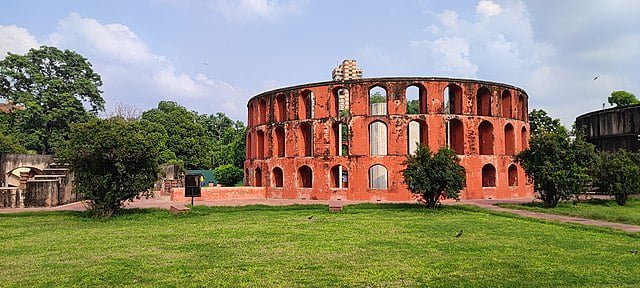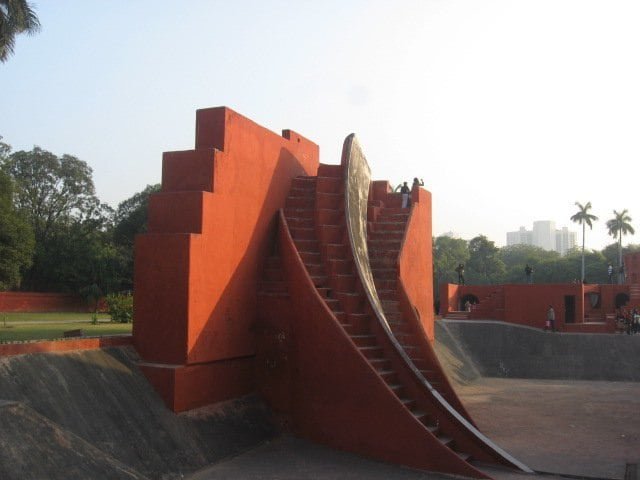Have you ever wondered how the ancient Indians measured the time, position and movement of the heavenly bodies? How did they make accurate predictions of the eclipses, equinoxes and solstices? How did they improve their calendar and astrology? The answer lies in Jantar Mantar, an old observatory that was built by a great king and astronomer, Maharaja Jai Singh II of Jaipur, in the 18th century. He built five observatories in different cities of India, but the one in Delhi was the first and the biggest.
Jantar Mantar has 13 huge instruments that look like sculptures or artworks, but they are actually very precise and functional. They can measure the time of the day, the position of the sun, the altitude of the stars, the equinoxes and solstices, and many other things. Jantar Mantar is also a UNESCO World Heritage Site, because it shows the rich scientific and cultural legacy of India. Visit during Delhi Local sightseeing By cab
What to Expect at Jantar Mantar

Jantar Mantar is located in a busy area of Connaught Place in New Delhi. It covers an area of about 4 acres and has 13 instruments made of brick, plaster and stone. The instruments have different shapes and sizes, such as triangles, circles, cylinders and spheres. They have different names such as Samrat Yantra (the king of instruments), Ram Yantra (the cylindrical instrument), Jai Prakash Yantra (the light instrument) and Mishra Yantra (the mixed instrument).
Each instrument has a special purpose and function, such as measuring the time of the day, the declination of the sun, the altitude of celestial bodies, the position of the equinoxes and solstices, etc. The instruments are also aligned with the cardinal directions and are based on the principles of Hindu cosmology and astrology.

Jantar Mantar was built by Maharaja Jai Singh II of Jaipur, who was a brilliant ruler and astronomer. He was unhappy with the existing astronomical tables and instruments, which he found to be wrong and outdated. He wanted to create new tables and instruments that would reflect the true state of the heavens and help him in astrological predictions. He also wanted to reform the calendar and synchronize it with the solar cycle. He consulted various scholars and experts from India and abroad, and studied various texts and manuscripts on astronomy.
He then commissioned the construction of five observatories in different locations in India: Delhi, Jaipur, Ujjain, Varanasi and Mathura. The Delhi observatory was the first one to be built and completed in 1724. The observatory was active for seven years, during which daily observations were made and recorded by a team of astronomers appointed by the maharaja. However, after his death in 1743, the observatory fell into neglect and decay. It was restored several times by various authorities, but it lost its original accuracy and functionality due to urbanization and pollution.
Jantar Mantar is not only a fascinating and intriguing place but also a significant and valuable site that represents the scientific and cultural heritage of India. It is a place where you can witness
How to Get to Jantar Mantar

Jantar Mantar is located on Sansad Marg near Connaught Place in New Delhi. It is easily accessible by metro, bus, auto-rickshaw or taxi. The nearest metro station is Patel Chowk on the Yellow Line, which is about 500 meters away from the observatory.
Jantar Mantar is open to public from 6:00 am to 6:00 pm on all days except national holidays and special occasions as notified by the authorities. The entry fee for Indian visitors is Rs 15 per person, while for foreign visitors it is Rs 200 per person. There is no charge for children below 15 years of age. There is also a nominal fee for photography (Rs 25) and video filming (Rs 50).
Why Visit Jantar Mantar

Jantar Mantar is a place that will inspire you with its ancient science and art. It is a place where you can learn about the history and evolution of astronomy in India and its connection with astrology and religion. It is a place where you can admire the artistic and architectural beauty of the instruments that were created with precision and skill. It is a place where you can experience the wonder and mystery of the cosmos and its influence on our lives.
Jantar Mantar is also a place that will connect you with the vision and mission of its builder, Maharaja Jai Singh II of Jaipur, who was a visionary ruler and astronomer. He was a man who wanted to advance the scientific and cultural knowledge of his people and his country. He was a man who wanted to create a new city that would reflect his glory and power. He was a man who wanted to harmonize the heavens and the earth.

Jantar Mantar is a place that you should not miss when you visit Delhi. It is a place that will enrich your mind and soul with its ancient wisdom and beauty.
FAQ’s
Q: How long does it take to visit Jantar Mantar?
A: It depends on how much time you want to spend in the observatory and its surroundings. Generally, it takes about an hour to visit Jantar Mantar and enjoy its beauty and splendor.
Q: What are the best times to visit Jantar Mantar?
A: The best times to visit Jantar Mantar are during sunrise and sunset, when you can see the instruments in their full glory and function. You can also visit during festivals such as Holi, Diwali and Makar Sankranti, when you can see various cultural events and celebrations at the observatory.
Conclusion
Jantar Mantar is a place that will amaze you with its ancient science and art. It is a place that will inspire you with its history and culture. It is a place that will connect you with the vision and mission of its builder, Maharaja Jai Singh II of Jaipur. It is a place that you should visit when you are in Delhi. It is a place that will enrich your mind and soul with its ancient wisdom and beauty. Jantar Mantar is a wonder of ancient astronomy that you should not miss.











Comments are closed.